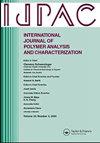Immobilization of α-amylase on electrospun polycaprolactone (PCL)/chitosan (CHI) nanofibers: a novel approach to improve enzyme stability and performance
IF 1.6
4区 工程技术
Q4 POLYMER SCIENCE
International Journal of Polymer Analysis and Characterization
Pub Date : 2025-10-03
DOI:10.1080/1023666X.2025.2505204
引用次数: 0
Abstract
Enhancing enzyme resistance to environmental conditions and optimizing their catalytic performance are crucial for various industrial applications. Enzyme immobilization has emerged as one of the most effective strategies to achieve these goals. In this study, polycaprolactone/chitosan (PCL/CHI) nanofibers were successfully synthesized via electrospinning, followed by the covalent immobilization of α-amylase. The immobilization efficiency was determined, and the resulting nanofibers were characterized through FT-IR, SEM, EDX, and XRD. Optimal pH and temperature conditions for the immobilized enzyme were found to be pH and 50 °C, respectively. The activation energy (Ea) calculated using the Arrhenius equation was 5.14 KJ/mol, while the kinetic parameters Km and Vmax were determined as 0.37 ± 0.11 mg/mL and 6.23 ± 0.87 µmol/min, respectively. Thermal stability tests revealed that at 50 °C, the immobilized enzyme retained over 50% of its initial activity. Additionally, the immobilized enzyme exhibited enhanced resistance to environmental stressors, including metal ions and organic solvents, compared to its free counterpart. The results confirm that the immobilization process not only improves enzyme stability but also boosts catalytic efficiency under specific conditions. This study provides a cost-effective, scalable, and practical approach for enzyme immobilization using electrospinning, with significant potential for industrial applications.
静电纺聚己内酯/壳聚糖纳米纤维固定化α-淀粉酶:一种提高酶稳定性和性能的新方法
提高酶对环境条件的抗性和优化其催化性能对各种工业应用至关重要。酶固定化已成为实现这些目标的最有效策略之一。本研究采用静电纺丝法制备了聚己内酯/壳聚糖(PCL/CHI)纳米纤维,并对α-淀粉酶进行共价固定。采用红外光谱(FT-IR)、扫描电镜(SEM)、电子能谱(EDX)和x射线衍射(XRD)对纳米纤维进行了表征。固定化酶的最佳温度和pH分别为50℃和50℃。利用Arrhenius方程计算得到的活化能Ea为5.14 KJ/mol,动力学参数Km和Vmax分别为0.37±0.11 mg/mL和6.23±0.87µmol/min。热稳定性测试表明,在50°C时,固定化酶保留了50%以上的初始活性。此外,与游离酶相比,固定化酶对环境应激因子(包括金属离子和有机溶剂)的抵抗力增强。结果证实,在特定条件下,固定化过程不仅提高了酶的稳定性,而且提高了催化效率。本研究为静电纺丝固定化酶提供了一种经济、可扩展、实用的方法,具有重要的工业应用潜力。
本文章由计算机程序翻译,如有差异,请以英文原文为准。
求助全文
约1分钟内获得全文
求助全文
来源期刊
CiteScore
3.50
自引率
5.30%
发文量
37
审稿时长
1.6 months
期刊介绍:
The scope of the journal is to publish original contributions and reviews on studies, methodologies, instrumentation, and applications involving the analysis and characterization of polymers and polymeric-based materials, including synthetic polymers, blends, composites, fibers, coatings, supramolecular structures, polysaccharides, and biopolymers. The Journal will accept papers and review articles on the following topics and research areas involving fundamental and applied studies of polymer analysis and characterization:
Characterization and analysis of new and existing polymers and polymeric-based materials.
Design and evaluation of analytical instrumentation and physical testing equipment.
Determination of molecular weight, size, conformation, branching, cross-linking, chemical structure, and sequence distribution.
Using separation, spectroscopic, and scattering techniques.
Surface characterization of polymeric materials.
Measurement of solution and bulk properties and behavior of polymers.
Studies involving structure-property-processing relationships, and polymer aging.
Analysis of oligomeric materials.
Analysis of polymer additives and decomposition products.

 求助内容:
求助内容: 应助结果提醒方式:
应助结果提醒方式:


